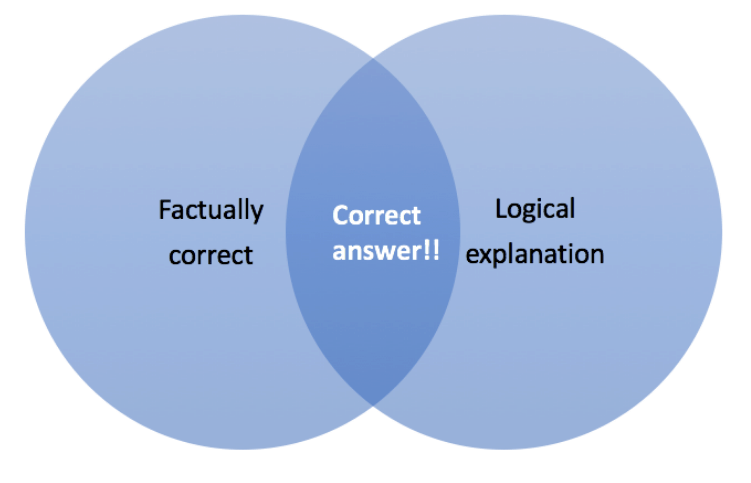On the MCAT, you will frequently encounter questions where you have to think about why something might happen, or why a given answer choice might support, refute, or explain a set of experimental findings. These questions can be challenging for many students because they are unlike the multiple-choice questions that often occur in undergraduate coursework. An important part of MCAT strategy is developing skills to handle MCAT questions that require interpretation or explanation.
Process of elimination can be especially helpful for these questions. When thinking about which answer is “best,” it can be easy to pick the most interesting or appealing answer choice, or to pick an answer choice that reflects speculative reasoning that goes beyond what the MCAT expects from you.

When answering MCAT questions that involve explanations, keep in mind that a correct answer choice must both be (1) factually correct or at least consistent with what we know about general science and passage information, and (2) a logical explanation for what the question is asking about. That means that any answer choice that fails either of those criteria can be eliminated. Let’s look at an example and see how this works in practice.
A Sample Question
Here’s a question for us to consider:
In prokaryotes, translation can begin to occur before transcription has finished. Which of the following explains this?
- Prokaryotes have ribosomes on their nuclear envelope and need not transport mRNA before translation.
- Prokaryotes have no endoplasmic reticulum and exclusively use bound ribosomes for translation.
- Prokaryotes lack a nucleus and thus need not transport the mRNA before translation.
- Prokaryotes have circular DNA which allows transcribed mRNA easy access to ribosomes.
Take a minute to analyze this question, and then we can move on to the discussion below.
Analyzing The Answer Choices
Since any correct explanation must be factually correct, our first step might be to check whether any of the answer choices contain empirical errors. In fact, we can eliminate A this way, as A implies that prokaryotes have a nucleus, which we should know to be false, as this is a basic difference between prokaryotes and eukaryotes.
Answer choice B also contains an empirical error, although it might not be as obvious. While it is true that prokaryotes have no endoplasmic reticulum (or any other membrane-bound organelles), this actually contradicts the statement made later in the answer choice that they use “bound ribosomes.” Bound ribosomes are bound to the endoplasmic reticulum, which prokaryotes do not have, so these two statements are logically inconsistent. We can therefore eliminate B.
Neither C nor D contains clear factual errors, so we must assess which answer choice is a better explanation for the fact that translation can co-occur with transcription in prokaryotes. With some careful consideration, we can conclude that D is not a convincing explanation, because we have no reason to think that circular versus linear DNA would make a difference in terms of mRNA molecules being able to make it to the ribosomes for translation. In contrast, C is a reasonable explanation, since in eukaryotes, the transport of mRNA through the nuclear membrane divides the processes of translation and transcription. We can now eliminate D and choose C as the correct answer choice.
Let’s return to B. Answer choice B does contain a factual error, but it’s relatively non-obvious, so what happens if we didn’t notice that mistake? We can still consider whether it makes sense, and it turns out that B is also not a very good explanation, because it does not provide any reason why translation and transcription could happen at the same time. B is unlike A in this sense; answer choice A is clearly empirically wrong, but if it were to be correct, it could be a possible explanation.
To summarize:
- Choice A is factually wrong, but logically plausible. Therefore, it can be eliminated.
- Choice B is factually wrong and logically implausible. Therefore, it can be eliminated.
- Choice C is factually correct and logically plausible. Therefore, it is correct.
- Choice D is factually correct but logically implausible. Therefore, can be eliminated.
Summing Up
A golden rule for MCAT strategy is that if anything about an answer choice is wrong, that answer choice must be completely wrong. They may give you an otherwise tempting, smart-sounding answer choice that has a single word that introduces an error—and that choice must be eliminated. In contrast, the correct answer choice may be relatively dull-sounding.
Correct answer choices for MCAT questions that require explanations can be visualized using a Venn diagram, as below:

Depending on the answer choices you’re given, it may be easier to start by screening for either incorrect statements or illogical statements. Either way, approaching interpretative questions through this lens can help you quickly eliminate incorrect answers, allowing you to spend your time more efficiently, and logically choose between two tempting answers (a common pitfall!).
If you’re just getting started with your prep, Next Step offers a free MCAT practice bundle that includes a half-length diagnostic, access to our first full-length practice test, and a demo of our online course. You can sign up for the free practice bundle here. If you’re looking for more comprehensive prep, we also offer one-on-one tutoring programs as well as an online MCAT course. Not sure where to start? Set up a free consultation with one of our veteran Academic Managers. They will go over your prep needs and help you decide what prep options are right for you.
Written by Blueprint MCAT (formerly Next Step Test Prep) MCAT experts.
Search the Blog

Free Consultation
Interested in our Online MCAT Course, One-on-One MCAT Tutoring or Med admissions packages? Set up a free consultation with one of our experienced Senior Student Advisors.
Schedule NowPopular Posts
-
MCAT Blog What's on the MCAT?
-
MCAT Blog How to Review MCAT Full Lengths

Free MCAT Practice Account
Need great MCAT practice?Get the most representative MCAT practice possible when you sign up for our free MCAT Account, which includes a half-length diagnostic exam and one of our full-length MCAT practice exams.
Learn More







